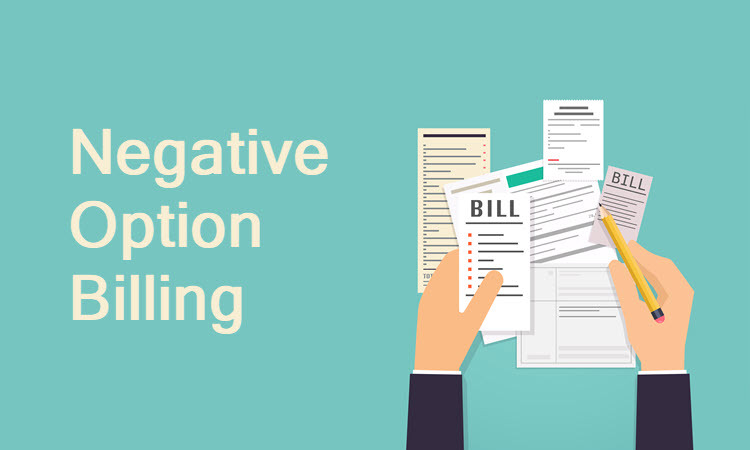Negative option billing is a common practice in ecommerce. It allows customers to try goods and services before committing to a long-term subscription. In the past, negative option billing had a bad reputation because it offered unscrupulous merchants the opportunity to take advantage of customers. For this reason, this billing model is now regulated and monitored by government bodies and card companies to ensure transparency and prevent abuse.
In this article, learn about negative option billing opportunities and challenges, regulation, and best practices.
What Is Negative Option Billing?
Negative option billing is the practice of automatically billing customers for a service when they don't explicitly terminate it. Businesses commonly use negative option billing for free trial offers. After the free trial period ends, a customer is either billed to continue using the service or the service ends if a customer opts-out before the first billing cycle ends.
Customers input their payment card information upfront for the offer to start. When the free trial or initial billing cycle ends, the customer is charged automatically. In essence, if the customer does not actively opt out of the subscription, the business takes this as consent and charges them.
Benefits of Negative Option Billing
If terms are communicated clearly, negative option billing benefits both merchants and their consumers.
- Expanded reach. The free or discounted trial period draws customers who might otherwise be reluctant to try a service or product.
- Increased conversion rates. Following a positive experience during the trial period, customers are likely to continue their subscription.
- Uninterrupted access. Customers get uninterrupted access to services through recurring payments without having to go through an opt-in process once their free trial ends.
Negative Option Billing Drawbacks
The main drawback of negative option billing is the increased chance of chargebacks. Customers resort to chargebacks if the merchant has not communicated the terms and conditions clearly and they feel deceived.
To prevent a high chargeback rate, merchants need to implement rules and policies that honor customers’ rights to easily opt-out during the trial period. If the customer can prove they failed to do so, the merchant automatically forfeits the right to representment, and the case is resolved in favor of the customer.
Due to the high chargeback rate tied to negative option billing, businesses that implement it are often automatically considered high-risk. Such businesses must satisfy additional requirements imposed by their acquiring bank and payment processor.

Note: High-risk businesses face challenges that require special payment processing solutions. With over two decades of experience, CCBill has the expertise high-risk merchants can trust.
What Are the Negative Option Billing Rules for Merchants?
Card companies dictate the rules for negative option billing to protect merchants and their customers.
Visa Negative Option Billing
The latest revisal of Visa’s negative option billing policies from 2020 extends to global merchants to include the following:
- Explicit consent. Merchants who accept electronic payments through Visa payment cards need their customers’ explicit consent to enter any recurring payment agreement. Customers provide consent via a signed consent form, pop-up box, confirmation email, or a signed letter in the mail.
- Timely notifications. Merchants need to send their customers notifications with cancelation links at least 7 days before any action takes place, whether it is the ending of a free trial, the beginning of a recurring payment, or a change in the terms of the agreement. These reminders must be sent via email or text and must include a copy of the subscription terms and conditions.
- Transaction receipts. Merchants are required to disclose the details of each transaction in their receipts, including the transaction amount, date, and the length of the billing period.
- Free trial confirmation. Customers need to receive separate confirmations about the free trials they signed up for, with details about the length and the amount charged ($0). Merchants must also clearly state that the customer will be charged after the free trial ends unless they cancel it on time.
Mastercard Negative Option Billing
Mastercard’s negative option billing rules oblige merchants to collect explicit consent from customers for any subscription agreement (including a free trial). Businesses must also allow customers to easily cancel the service online and provide email receipts for each transaction, initial or recurring.
The latest revision of Mastercard’s negative option billing policies from 2021 expands to include the following:
- Disclosure at the point of payment. The checkout page, or point of payment, must include all terms of the subscription and the free trial, such as the amount, payment date, and payment frequency. Merchants must present these terms to customers without them having to take any action (e.g., scroll or follow a link to find the terms and conditions) before they finalize the payment.
- Enrollment confirmation. Merchants need to send their customers confirmation emails after they sign up for a subscription. The email must contain the same details as the checkout page.
- Upcoming payment notifications. Merchants must notify their customers of upcoming payments 3 to 7 days before the free trial ends. For recurring payments at least six months apart, merchants must notify customers 7 to 30 days before the billing date.
- Cancelation confirmation. When customers cancel a trial period or a negative option billing plan, merchants must send them a confirmation.

Negative Option Billing Best Practices
These are the best practices for merchants who want to introduce negative option billing to customers.
Provide Full Disclosure
Customers need to know the terms and conditions of the subscription agreement from the get-go. This includes product and services descriptions, pricing, frequency of payments, and a clear explanation regarding free trials. Terms and conditions should be direct, concise, and easily accessible to avoid confusion and misinterpretation.
Make Cancelation Easy
Businesses should ensure that their customers are made fully aware of the cancelation policies. They must give subscribers enough time to cancel their subscription or free trial before they are charged.
Merchants must include a cancelation link in the notification email they send ahead of the next billing cycle. They should also provide instructions on how customers can unsubscribe and re-subscribe if they change their minds.
Always Obtain Written Consent
Merchants need to receive explicit written consent from customers before entering a subscription agreement with them. They can obtain it via:
- A check box
- A signed electronic form
- A physical letter
- A confirmation email with a link they must click
Send Timely Payment Reminders
Although merchants automatically charge for subscriptions, customers still appreciate being notified about an upcoming payment. This way, they will not be unpleasantly surprised when they are charged for a subscription they might have forgotten about. It also gives them enough time to cancel their subscription if necessary.
Provide Enrollment and Payment Confirmations
Merchants should send their customers a confirmation email when they enter subscription agreements, as well as payment confirmations for each transaction. This way, customers can go back to their inboxes to check the terms they signed up for and obtain billing details that correspond to their bank statements.
Keep Updated with Rules and Regulations
The U.S. Federal Trade Commission and card companies occasionally revise negative option billing policies to further protect customers. Merchants should make sure they are up to date with all of them to ensure compliance and keep chargeback rates low.
Provide Helpful Customer Service
Customers need an easy way to reach customer support for any issues with their subscriptions or cancelations. Alternatively, they will go to their bank and resolve the issue through a chargeback. To avoid this, merchants should provide helpful and accessible customer support, either through live agents or chatbots.

Is Negative Option Billing Legal?
Negative option billing is legal in most countries around the world. However, it is regulated on a state or regional level. Some notable examples of the practice being banned include the Canadian provinces of Alberta and Ontario.
When it comes to the U.S., negative option billing is a legal business practice in all U.S. states except Michigan. It is regulated by the Federal Trade Commission (FTC) and card companies to ensure customers are protected. The FTC uses the term "negative option marketing" for all commercial transactions in which businesses charge customers in case they fail to take affirmative action to cancel the agreement.
The FTC defines four types of negative option billing plans.- Automatic renewal. Subscriptions are renewed automatically after they expire unless the customer cancels them.
- Continuity plan. Customers agree in advance to periodically receive goods and services until they cancel the agreement.
- Free-to-pay (nominal-fee-to-pay) plan. Customers have access to goods and services for free or a nominal fee during a trial period. After this period, they are charged automatically to continue using them unless they decline the offer.
- Prenotification plan. Customers receive periodic offers for goods and services. If they do not decline the offer, merchants charge them for these goods and services.
Conclusion
Negative option billing can provide benefits for merchants and consumers if all steps of the process are communicated clearly and honestly. The FTC and card companies require merchants to disclose all the details of their subscription offer beforehand to protect customers’ rights. The regulations also help keep chargeback levels down.
Before implementing this billing method, safeguard your business by following best practices.
